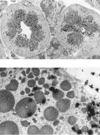Histology and Its Methods: Part I Flashcards
(53 cards)
____________ is the study of tissues of the body and how these tissues are arranged to constitute organs
Histology
What are two crucial understandings to the study of histology?
- All living things are composed of cells and cell products
- All diseases result from disorders in cellular function
What are the basic levels of organization from smallest (atom) to largest (organism)?
Atom
Molecule
Cell
Tissue
Organ
Organ System
Organism
What is a tissue?
A group of similar cells from the same origin that together carry out a specific function
What is an organ?
A group of tissues that are formed by function
What two interacting components become functionally specialized to give rise to tissues?
- Cells
- Extracellular matrices
The ______________ _________ supports cells and contains fluid for transporting nutrients to cells and carrying wastes away from cells
Extracellular matrix
What are the four basic tissue types?
- Epithelium
- Connective
- Muscle
- Nerve
______________ tissue covers body surfaces, lines body cavities, and forms glands
Epithelial
______________ tissue underlies or supports epithelial, muscle, and nervous tissue, both structurally and functionally
Connective
What type of tissue is blood?
Connectivve
_____________ tissue is composed of contractile cells, which underlie aspects of motility
Muscle
_____________ tissue receives, integrates, and transmits information from outside and inside the body to control activities of the body
Nervous
How many types of muscle tissue are there?
Three: muscle, cardiac, and smooth
Of the three muscle tissues, which two are striated?
Muscle and cardiac
Of all the tissue types, which is the least plastic, leaving it prone to damage and disorder?
Nervous
There are two general methods for studying tissues: microscopy and ___________ ____________
Molecular techniques
_____________ microscopy is based on the interaction of light and tissue components that’s often used to reveal and study tissue features. Types of this microscopy include bright-field, fluorescence, phase-contrast, confocal, polarizing, and differential interference
Light
What is resolving power?
The smallest distance between two objects at which they can still be seen as separate objects; resolving power determines the quality of the image and is dependent upon the quality of objective lenses
What is the resolving power of a light microscope?
0.2 µm
The resolving power of a light microscope is around 0.2 micrometers, which allows us to see cellular components like a _____________ or cytoplasmic filament
Ribosome
In ________________ microscopy, tissue sections are irradiated with UV light and the emission is in the visible portion of the spectrum, resulting in bright colors against a dark background
Fluorescence
_________________ microscopy involves modified light microscopes that can be used to study unstained cells and tissue sections; images are generally transparent and colorless but can be used to view living, cultured cells
Phase-contrast
The image is produced by what type of microscope?

Phase contrast







